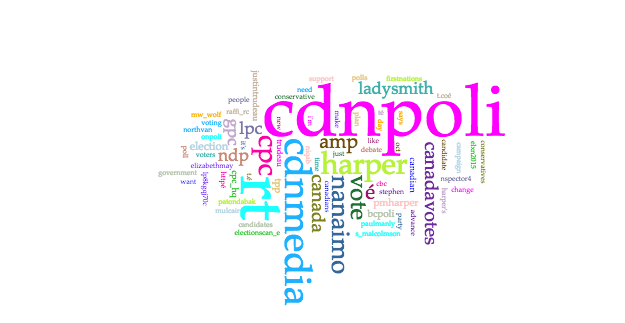[waveplayer progress_color_2=”#65ab45″ progress_color=”#65ab45″ cursor_color=”#a8a8a8″ cursor_color_2=”#5b5b5b” ids=”505″]
Audio transcript
What happens in Canadian communities that are underserved by national media outlets when local news outlets close down? We decided to take a look at this question, using the 2015 Canadian election as a case study. We focused on one small community in particular: Nanaimo, B.C., since this community recently went through the closure of one local news outlet: The Nanaimo Daily news, which closed in 2016 after the election, making it an ideal site for analysis.
Nanaimo, B.C. is a small city on the East Coast of Vancouver Island. The most recent Statistics Canada data available puts the population of Nanaimo at 83,810 people, though this number is likely still increasing due to its popularity as a Canadian retirement location. Nanaimo has a mild climate and is located about 1.5 hours north of B.C.’s capital city, Victoria, and about a 1.5 hour ferry ride from the north end of Vancouver, B.C., both of which could be considered media centres, since Victoria and Vancouver both have multiple radio stations, TV stations, and print media outlets. Nanaimo was originally founded as a coal-based economy, now its major industries are tourism, pulp and paper, the provincial government, and the service industries. Politically, Nanaimo is part of the Nanaimo–Ladysmith riding (for federal government) and has voted NDP in the last two federal elections. Since the closure of the Nanaimo Daily News in 2016, Nanaimo has two local newspapers: The Harbour City Star and the Nanaimo News Bulletin, and four local radio stations: CHWF-FM (The Wolf), CKWV-FM (The Wave), CHLY-FM (campus radio at Vancouver Island University), and CKAY-FM (The Coast).
The Nanaimo Daily News was a Canadian-only daily (weekday) newspaper in Nanaimo, B.C. While it boasted a 141-year history before closing in 2016, in the last six years of its life it changed hands three times. It was owned by Southam in the 1990s, then was bought by CanWest in 2000, Postmedia in 2010, Glacier Media in 2011, and then finally Black Press in 2015 before closing in January 2016. In the month leading up to the 2015 Canadian election, the Nanaimo Daily News published 157 election related articles, but only one Facebook post and no tweets related to the election. This lack of engagement with social media suggests that the January 2016 shut down was known during the 2015 election, as the paper seemed to be on maintenance mode.
Across North America, recent research has revealed the importance of local news for civic and political participation in Canada. Research by Lee Shaker at Portland State University demonstrated that civic engagement in Seattle and Denver decreased immediately following the closure of local news outlets. Other studies, such as one completed by Phil Napoli’s team at Duke University in 2015 have shown that communities in New Jersey with lower incomes have less access to local news than communities with higher incomes. This is problematic because, as the Knight Commission has noted, the availability of information “is as vital to communities as is clean air, safe schools, good hospitals, and public health.”
Despite the civic benefits of local news to communities in Canada and around the world, the news industry is currently at a crossroads. A recent report by Pew research shows that advertising revenue to the newspaper industry is declining sharply. Classified ads, once a cornerstone of the newspaper business model, have become almost obsolete, and since 2008, newspapers in the U.S. have consistently reported losses as a result of the availability of free online information through social media channels. As a result, smaller newspapers are being closed down entirely, or consolidated into larger news outlets. And the newspapers that still exist are having to do more with less. Despite declines in employment in this industry, journalists are often expected to report on a news story in the traditional way, then post the story to multiple social media platforms, often in multiple formats. With a 24 hour 365 day a year cable and digital-fueled news cycle, these stories are often needed in multiple formats on an extremely tight timeline. This means that news outlets tend to rely on press releases and other forms of quick journalism more than they ever have before—out of necessity.
Many people think that social media, and particularly Twitter, which is used frequently by journalists to find and share news, can help bridge this gap. Recent research by Pew Research shows that not only is social media becoming an increasingly popular source of news, but that Twitter in particular is evenly divided between those who simply come across news by accident, and those who seek it out on the platform, meaning that for many people Twitter is thought of as a source of news. But how does this source compare to, for example, the local news outlets that are on the decline? Research by Pew shows that local news does not always get shared on outlets like Twitter. Studies have also shown that certain Twitter users demonstrate an outsized ability to get their messages out. For example, researchers like Tamara Small in 2011 showed that traditional journalists and other celebrity tweeters are more likely to have their tweets amplified by others.
Despite this, Twitter is increasing as a popular source of news for social media users. A recent study by Pew research, which I will link to in the show notes, shows that about six out of 10 Americans get their news from social media, with Reddit, Facebook, and Twitter being the top three platforms where people report getting news. And about half of the people who do come across news on Twitter are actively seeking it out—they are turning to Twitter to find specific news on a topic, or they’re using Twitter as a source of general news updates.
When people go to Twitter to find news related to a specific topic, they must engage in strategies to help them filter their topic of interest from the millions of other tweets on the platform. This filtering tends to occur in two ways: Top down and bottom up. Top down filtering occurs when Twitter’s algorithm sorts through the posts to deliver a search result, or structure what a person sees in their feed at a given time. Bottom up filtering occurs when people use hashtags to categorize their own posts, and then to search the posts of others. Even the top down filtering methods however are, in-part, informed by user hashtag use, as hashtags are one of the signals that Twitter uses when searching and categorizing specific topics. This makes hashtags extremely important for a discussion of election news. Hashtag use for any given topic on Twitter tends to follow a power-law distribution, meaning the most popular hashtags for a topic will end up including the majority of interested people in the conversation about it. In the case of the 2015 federal election, the most popular hashtag, #elxn42, was not only trending on Twitter during the election, but was also regularly used in traditional media sources, such as television news coverage. A search of this hashtag and associated key words revealed a second hashtag, #cdnpoli, that was also regularly associated with the election, so we can expect these two hashtags would be used in the majority of posts made by people who were interested in election related news.
My research team used Tweet Archivist to scrape Twitter for the two most popular election related hashtags, #elxn42 and #cdnpoli, for a month leading up to the 2015 Canadian Federal election. We filtered those hashtags to find Nanaimo-specific data by identifying all Tweets that mentioned Nanaimo, and all accounts that self-identified as being from Nanaimo. Then we compared the stories available on Twitter to the election related news available from the Nanaimo Daily News during this time period, which we identified by the presence of election related keywords.
We found a difference in what was available on Twitter and what was offered in the Nanaimo Daily News during the election. The top ten election-related topics covered by the Nanaimo Daily News in the month leading up to the 2015 Canadian federal election were, in order of frequency: political strategy, voting related news, election results, trade policy, integrity, immigration, environment, government spending (including taxes and deficits), opinion polls, and health. Local issues (such as events, or the local race for MP) were discussed in coverage about 37 per cent of the time. The top ten topics discussed on Twitter in the month leading up to the 2015 Canadian federal election were, in order: leadership, political strategy, voting related news, integrity, other, immigration, trade policy and the TPP, environment, economy or jobs, and finally Indigenous issues. Instead of local issues or events, Twitter discussion focused mainly on people or issues that were national in scope, such as the party leaders or the hijab debate.
I’ve included two word clouds in the show notes. One shows word frequency in the headlines of the Nanaimo Daily News election-related articles, and the other shows word frequencies in the scraped tweets. We compared headlines to tweets here in order to compare like to like. Tweets have more in common with headlines than they do with full news stories, and often a tweet will lead to an expanded story in a blog or linked news article. The most frequent words in the Nanaimo Daily News headlines leading up to the election were: Candidates, election, NDP, Tories, vote, Liberal, TPP, Canada, deal, Harper, and the most frequent words in the Nanaimo tweets leading up to the election were RT (as in, retweet), cdnpoli, cdnmedia, Harper, CPC (as in, Conservative Party of Canada), Nanaimo, vote, Canadavotes, Canada, and LPC, which stands for the Liberal Party of Canada. Important to note here is that the candidates, including local candidates, were the most frequent headline key word in the Nanaimo Daily News, and while Nanaimo shows up on the list of top ten tweet keywords by word frequency, it was only present in about 9 per cent of the total tweets. In fact, when we hand coded the data, 170 tweets out of 1,585 were locally relevant. They mentioned maybe the local race for MP, local events, or local news in the Nanaimo area. That’s slightly less than 11 per cent of the entire sample of Nanaimo, B.C. tweets, which is significant because our sampling strategy, which specifically included tweets that mentioned Nanaimo, should have favoured the collection of local news.
We also noticed a distinct difference in the tone or type of coverage between the Nanaimo Daily News and the Nanaimo, B.C.-based election tweets. Whereas coverage in the Nanaimo Daily News reflected key journalistic standards and practices such as detailed and balanced reporting, Twitter showed an abundance of opinion and controversial topics. For example, the hashtag #cdnmedia was the third most frequently used word in our Twitter sample, and it was often used in a derogatory way, to refer to the fact that the Canadian media could not be trusted. It suggested that mainstream media sources were unfairly biased against the Conservative Party. Additionally, we coded tweets based on whether they were solidly for or against a political party and found that the majority of tweets, 1,125 in this case, were strongly in support of or against a particular party, whereas only 460 could be considered non-partisan. Certain topics on Twitter were overwhelmingly partisan. “Leadership” for example, had only 13 out of 279 posts that were coded as non-partisan, and “integrity” had 27 out of 188 posts coded as non-partisan. In the case of “integrity,” the majority of posts coded non-partisan were claims of a lack of integrity within the media.
Overall, we saw that Twitter did not provide either the coverage of local issues, nor the attention to the issues that would be needed for people to make an informed voting decision in their community. Particularly compared with a local news outlet, there are gaps in information that suggest that Twitter is not a medium that can replace declining local news outlets in Canadian communities that are underserved by larger media outlets. Despite the challenges that the Nanaimo Daily News was clearly facing before its shut down, it was still producing more robust and more accurate pieces on the election than the ones that were being shared widely on Twitter.
Thus we must be cautious when we are recommending that journalists move to social media or that citizen journalism can make up the local news gap. Instead, we must be cognizant that a robust local news ecosystem is necessary to complement, and also provide content for, social media sites like Facebook and Twitter, particularly during a time of an election.
Thank you for listening, this research was in part funded by Ryerson, and the Social Sciences and Humanities Research Council of Canada, and Royal Roads University. Our music and sound effects today were Creative Commons license. The music was by Dr. Turtle, and was called “His Last Share of the Stars,” available from the Free Music Archive. All sound effects were available from the SoundBible.com.
Thanks again, and I hope you have a great day. Remember, support your local news outlet.
Figures referenced in podcast:
Figure 1: Word cloud showing keywords from Nanaimo Daily News headlines

Figure 2: Word cloud showing tweet keywords


